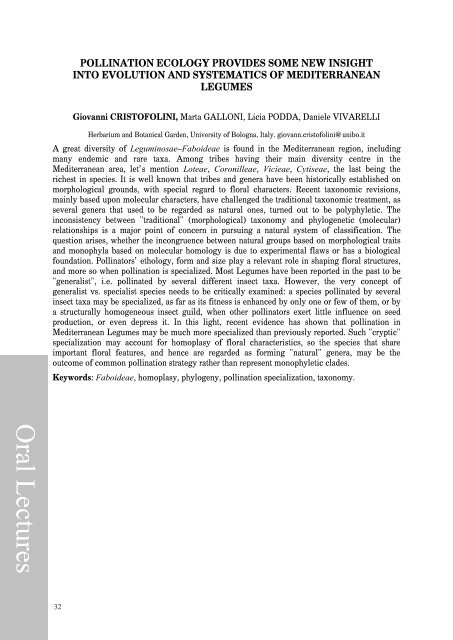Adil GÜNER, Vehbi ESER - optima
Adil GÜNER, Vehbi ESER - optima
Adil GÜNER, Vehbi ESER - optima
You also want an ePaper? Increase the reach of your titles
YUMPU automatically turns print PDFs into web optimized ePapers that Google loves.
Oral Lectures<br />
32<br />
POLLINATION ECOLOGY PROVIDES SOME NEW INSIGHT<br />
INTO EVOLUTION AND SYSTEMATICS OF MEDITERRANEAN<br />
LEGUMES<br />
Giovanni CRISTOFOLINI, Marta GALLONI, Licia PODDA, Daniele VIVARELLI<br />
Herbarium and Botanical Garden, University of Bologna, Italy. giovann.cristofolini@unibo.it<br />
A great diversity of Leguminosae–Faboideae is found in the Mediterranean region, including<br />
many endemic and rare taxa. Among tribes having their main diversity centre in the<br />
Mediterranean area, let’s mention Loteae, Coronilleae, Vicieae, Cytiseae, the last being the<br />
richest in species. It is well known that tribes and genera have been historically established on<br />
morphological grounds, with special regard to floral characters. Recent taxonomic revisions,<br />
mainly based upon molecular characters, have challenged the traditional taxonomic treatment, as<br />
several genera that used to be regarded as natural ones, turned out to be polyphyletic. The<br />
inconsistency between "traditional" (morphological) taxonomy and phylogenetic (molecular)<br />
relationships is a major point of concern in pursuing a natural system of classification. The<br />
question arises, whether the incongruence between natural groups based on morphological traits<br />
and monophyla based on molecular homology is due to experimental flaws or has a biological<br />
foundation. Pollinators’ ethology, form and size play a relevant role in shaping floral structures,<br />
and more so when pollination is specialized. Most Legumes have been reported in the past to be<br />
"generalist", i.e. pollinated by several different insect taxa. However, the very concept of<br />
generalist vs. specialist species needs to be critically examined: a species pollinated by several<br />
insect taxa may be specialized, as far as its fitness is enhanced by only one or few of them, or by<br />
a structurally homogeneous insect guild, when other pollinators exert little influence on seed<br />
production, or even depress it. In this light, recent evidence has shown that pollination in<br />
Mediterranean Legumes may be much more specialized than previously reported. Such "cryptic"<br />
specialization may account for homoplasy of floral characteristics, so the species that share<br />
important floral features, and hence are regarded as forming "natural" genera, may be the<br />
outcome of common pollination strategy rather than represent monophyletic clades.<br />
Keywords: Faboideae, homoplasy, phylogeny, pollination specialization, taxonomy.<br />
20






